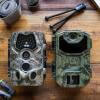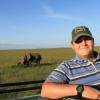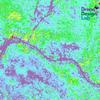Wildlife crime is one of the greatest challenges facing conservation, and one of the conservation tech world's biggest areas of innovation. With new ideas and solutions constantly being put forth to track and protect species targeted by poachers, manage protected areas and support rangers, and combat the growing online market for illegal wildlife products, the engineers and conservationists working to solve wildlife crime's many challenges rely on tools like machine learning, biologging, camera traps, acoustic monitoring, drones, mobile apps, and more.
This wide variety of overlapping technology makes our Wildlife Crime group a potential melting pot for many of our other communities, and makes it an especially exciting place to find collaborators working in different tech spheres to meet a common goal. Whether you're a camera trap expert looking for information on thermal vision to spot potential poachers, a machine learning expert with the skills to analyze acoustic data for gunshots, or a protected area manager seeking the latest integrated mobile tools, this group can connect you with the right members of our community!
Below, you'll find WILDLABS resources and conversations to help you understand how different technologies are being put to work in the fight against wildlife crime, and what conservation tech practitioners need for these tools to be effective.
Three Tutorials and Videos for Beginners:
- How do I use AI to fight wildlife crime? | Lily Xu, Tech Tutors
- WWF Wildlife Crime Technology Project | Eric Becker, Virtual Meetups
- SmartParks | Laurens de Groot, Virtual Meetups
Three Forum Threads for Beginners:
- Snare detection technologies | Rachel Kramer
- Tools for conservation management | Chris Muashekele
- Looking for Intelligence Database Software | Dexter Oelrichs
Three Articles for Beginners:
- Using AIS data to investigate the world's fishing ports, Max Schofield
- How do Wildlife Crime Experts view Remote Sensing Technologies used to Combat Illegal Wildlife Crime?, Isla Duporge
- Metal Detecting Sensors for Anti-Poaching, Sam Seccombe
Join this group now to get to know our community and start discussing solutions and ideas together!
Header photo: © Frank af Petersens/Save the Elephants
Neuroscientist & engineer looking for a data/R&D role in conservation.
- 0 Resources
- 0 Discussions
- 17 Groups
- @hyodopenguin
- | she/her
I am currently a rising junior at UC Berkeley studying data science. I hope to apply data with biodiversity, especially by utilizing camera traps for species classification. People in conservation tech are truly living my dream careers, and I can't wait to get even more inspired!

- 0 Resources
- 5 Discussions
- 23 Groups
Mobile developer w/ a passion for nature and conservation

- 0 Resources
- 16 Discussions
- 6 Groups
Spanish veterinarian interested in wildlife conservation
- 0 Resources
- 0 Discussions
- 14 Groups
OSINT analyst and investigator including wildlife crimes. Writer of children's animal books and articles for Animal World For Kids teaching about animal cognition, symbiosis and behaviour.
- 0 Resources
- 0 Discussions
- 3 Groups
- @Mumonkan
- | he / him
Conservation X Labs & Wild Me
Software Engineer for Wildlife Conservation

- 0 Resources
- 4 Discussions
- 11 Groups
- 0 Resources
- 0 Discussions
- 6 Groups
Wildlife Drones
Wildlife Drones has developed the world’s most innovative radio animal-tracking system using drones so you can track your radio-tagged animals like never before.


- 18 Resources
- 8 Discussions
- 32 Groups
Serendipity Wildlife Foundation
CEO, Serendipity Wildlife Foundation
- 0 Resources
- 5 Discussions
- 4 Groups
Fauna & Flora
Countering poaching and IWT

- 0 Resources
- 6 Discussions
- 2 Groups
- 0 Resources
- 0 Discussions
- 17 Groups
University of Adelaide

- 0 Resources
- 10 Discussions
- 17 Groups
Society’s Marine Protection Prize will award $450,000 for innovative solutions and technologies that protect and sustain fisheries in coastal communities
1 February 2018
‘The Field’… Say the words ‘The Field’ to a group of conservationists and it will immediately conjure up vivid memories of everything from sticky wet rainforests to burning dusty deserts. What’s more, it’s almost...
17 January 2018
The WWF Wildlife Practice has a small amount of funding available to provide grants of around €10,000 to support key innovative ideas.
11 January 2018
Following the UK Government’s landmark announcement of plans to introduce a complete ban on the domestic trade in ivory, it was fitting that a new machine learning product designed to tackle the supply end of this...
6 December 2017
The inherent complexity of not only deploying technologies in the field but also doing so in a scientifically rigorous manner can prove a substantial barrier for the effective use of conservation technologies, and clear...
11 October 2017
To spur continued progress in advancing the promising solutions that have emerged through the Wildlife Crime Tech Challenge, USAID have awarded three of their 16 Prize Winners an additional Acceleration Prize, worth a...
29 September 2017
The Domain Awareness System (DAS) is a revolution in monitoring technology, creating real-time awareness of protected areas assets. This technology has the potential to completely change standard monitoring procedures...
26 September 2017
Welcome to an installment of a new series from the Wildlife Crime Tech Challenge in which we will be sharing updates from their 16 Prize Winners who are working to combat wildlife crime around the globe. This fourth...
17 August 2017
Funding
The European Space Agency is calling for Kick-Start ideas to leverage space technology for wildlife protection. Three main topics of interest have been identified: 1) Wildlife monitoring, tracking and inventory, 2)...
5 July 2017
Its been a busy couple of months for the Open Acoustic Devices team. They've just returned back from Belize where they have been trialling the new AudioMoth design for gunshot detection. Find out what they've been up to...
27 June 2017
Welcome to an installment of a new series from the Wildlife Crime Tech Challenge in which we will be sharing updates from their 16 Prize Winners who are working to combat wildlife crime around the globe. Slow lorises...
23 June 2017
In this From the Field interview, we speak to Eric Becker, a conservation technology engineer at the World Wildlife Fund US. He talks about his work in technology design and the key challenges he's experienced...
22 May 2017
June 2025
event
July 2025
November 2023
May 2023
event
42 Products
1 R&D Projects
41 Organisations
Recently updated products
Recently updated R&D Projects
Recently updated organisations
| Description | Activity | Replies | Groups | Updated |
|---|---|---|---|---|
| The European project Nature FIRST is hosting its final conference at Ouwehands Dierenpark in the Netherlands on 25–26 June 2025,... |
|
Community Base, Conservation Tech Training and Education, Data management and processing tools, Earth Observation 101 Community, Emerging Tech, Human-Wildlife Conflict, Protected Area Management Tools, Wildlife Crime | 7 hours 47 minutes ago | |
| Hi Georg,Oh, that's a pity. But thanks anyway for checking!Really appreciate it!CheersMartina |
+10
|
Wildlife Crime | 1 week 2 days ago | |
| Hi Adam! Sounds like you have your work cut out for you. I have not used radar systems or AI systems for this sort of detection, but there are methods using change detection... |
|
AI for Conservation, Drones, Wildlife Crime | 1 month ago | |
| Hi @iainmcnicol , welcome to WILDLABS! Thanks for posting this on here. I have shared with my colleagues at Fauna & Flora who have some experience (especially with the... |
|
Community Base, Geospatial, Protected Area Management Tools, Wildlife Crime | 1 month 1 week ago | |
| Great dear Travis,This is a great news and an opportunity to me and my local bee keepers. It really sounds very helpful.Here is my contacts:Email: muganyizi@pales.or.tz ... |
|
Climate Change, Conservation Tech Training and Education, East Africa Community, Funding and Finance, Human-Wildlife Conflict, Wildlife Crime | 1 month 2 weeks ago | |
| You can also check out WWF's newly launched C2C: Conflict to Coexistence approach. It provides a framework and methodology for developing tailor-made human-wildlife conflict (HWC... |
+2
|
Wildlife Crime | 3 months 1 week ago | |
| Not a book, but a very real documentary:Stroop - Journey into the Rhino Horn War |
|
Wildlife Crime | 3 months 2 weeks ago | |
| Thank you so much for sharing! They seem to only state the official DFFE statistics nowadays. From my connections in SouthAfrica these numbers don't always seem to reflect... |
|
Wildlife Crime | 3 months 2 weeks ago | |
| Hey Xiona,I see that you are from a university that is very close to where I live. I have a platform that is well suited for combating wildlife crime and I perceive that it’s... |
+5
|
Wildlife Crime, Acoustics, Latin America Community | 4 months 3 weeks ago | |
| Hats off to your team for this absolute game-changing technology! We rescue stray and wild animals in Taiwan, and the bulk of our work is saving animals maimed by wire snares... |
+37
|
AI for Conservation, Drones, Emerging Tech, Human-Wildlife Conflict, Wildlife Crime | 6 months ago | |
| Because spotting the trucks on the roads is trivial. You could do it from 150m or further away in complete darkness. If this interests someone then I have a solution to do that. |
|
Wildlife Crime | 7 months 1 week ago | |
| Thanks, we know they are breeding these animals here, I asked, since it's seems to be an expensive hobby, we need to allocate more funding for rural women in entrepreneurship and... |
|
Acoustics, Animal Movement, Citizen Science, Human-Wildlife Conflict, Protected Area Management Tools, Wildlife Crime | 7 months 1 week ago |
Ivory ID using portable molecular sensors?
1 July 2016 4:01pm
26 July 2016 4:40pm
Thanks, @Peter+Apps . I reached out to ConsumerPhysics for more information. They said that scanning animal ivories for identification purposes is likely to be feasible with SCiO and that others may be considering this application as well.
They confirmed that SCiO uses NIR spectroscopy for classification between different substances, providing that the molecular fingerprints are different enough from each other. It sounds like they did a basic feasibility test that "showed promise in classifying ivory samples from different kinds of animals - elephant, mammoth, hippopotamus and walrus, as well as plastic mock-ivory samples. The corresponding molecular sensing models and applications will have to be developed further for better insight. This may be developed in the future either by us or by the SCiO developer community using the SCiO Development Toolkit, which allows users to create models and apps."
They suggested that a user would need to take two things into consideration when working toward this application: "First, as SCiO’s detection threshold varies by material, and is typically 0.1%-1%, some micro-nutrients will not be detectable. This requires further research. In addition, it should be noted that building the database for such an application requires access to samples and their chemical characteristics."
More info on DevKit SDK is online here: https://www.consumerphysics.com/myscio/developers/ and here: https://www.youtube.com/watch?v=6wDLSF0ZkIA. I have no experience with this technology and no connection to ConsumerPhysics, but it sounds interesting.
I think this could be a good research project for someone in the WILDLABS community. With the scope of our network, gaining access to samples should not be a challenge.
26 July 2016 7:06pm
It sounds like @David+Baisch at Conservation X Labs just ordered a SCiO spec and developer's kit to test its sensitivity. They're interested in seeing whether the device can be used to differentiate beteween tree species in treated and untreated wood products. Looking forward to learning more about that process!
Video: Discover the SMART Approach
 The SMART Partnership
The SMART Partnership
20 July 2016 12:00am
New rhino poaching report out
11 July 2016 1:36pm
Can Drones Live up to the Hype?
8 July 2016 12:00am
Wildlife Crime Tech Challenge Accelerator Bootcamp
24 June 2016 12:00am
TEAM Network and Wildlife Insights
28 April 2016 12:00am
Wildlife Crime Apps
13 April 2016 3:46pm
The Spatial Monitoring and Reporting Tool (SMART)
15 March 2016 12:00am
Disruptive Technology: Embracing the Transformative Impacts of Software on Society
10 March 2016 12:00am
15th International Elephant & Rhino Conservation and Research Symposium
4 March 2016 12:00am
Bringing Conservation Technology to Life
17 February 2016 12:00am
JIGZAW and Mars Omega, an introduction
2 February 2016 3:17pm
3 February 2016 4:44am
Thanks Anthony - what is the best way to introduce others to your product and solutions? I live in Kenya - can you disclose who you are working with here?
With regards to a scale up partner, can you provide a few more details on what you are looking for?
Gautam!
3 February 2016 10:08am
Hi Gautam,
I think the best way is have them read the thread, and then get back to me with questions - I can then respond on a case-by-case basis. Our website is here: http://www.marsomega.com. We have not yet updated it to make public our involvement in countering wildlife crime, but that will be done shortly.
On disclosure, Hamish is actually in Kenya from tomorrow, and he is talking to our Kenyan partners to make sure they are happy to have this information made more freely available. We necessarily are being very discreet.
On scaling - as one of the 16 Prize WInners in the Wildlfe Criem Tech Challenge, we have only just started talking to the competition sponsors about acceleration and scaling. Once we have established that process and have more information ourselves, I will be happy to discuss this further.
Best regards,
Anthony
JIGZAW - information collection and use
3 February 2016 9:55am
Report outlines 2016's most pressing conservation issues
3 February 2016 12:00am
Illegal wildlife sales on social media
4 January 2016 3:56pm
26 January 2016 4:14pm
This post made me wander whether we could employ social media listening tools to identify illegal wildlife trade hotspots, levels, changes in attitude towards IWT products etc.? Perhaps already being done? Here's some case studies from Brandwatch of how brands are using social media listening: https://www.brandwatch.com/case-studies/
Real-time anti-poaching tags to prevent imminent species extinctions?
22 January 2016 2:49pm
Wildlife Crime Tech Challenge: Winners Announced!
22 January 2016 12:00am
The Impact of the Internet of Things
10 December 2015 12:00am
Gaming for Good: Minecraft and Quiz Up
3 December 2015 12:00am
Harnessing Big Data to Combat Illegal Wildlife, Timber and Fisheries Trade
 Rachel Kramer
and 2 more
Rachel Kramer
and 2 more
26 November 2015 12:00am
Technology for Traceability
 Daniel Brizuela
and 1 more
Daniel Brizuela
and 1 more
26 November 2015 12:00am
Gaming for Good: Runescape and Angry Birds
25 November 2015 12:00am
Nov 18th: Cheap Space, DIY Imaging and Big Data
9 November 2015 2:36pm
What is eDNA?
2 November 2015 12:00am
























































12 July 2016 7:37pm
There are so few details on the link that it is not possible to judge whether that particualr hardware will be any use for anything. I suspect that it used near infra-red which has some applications for bulk anayses of foods but I doubt that it could distinguish different types of animal ivory. It might be able to discriminate between vegetable and animal ivory.